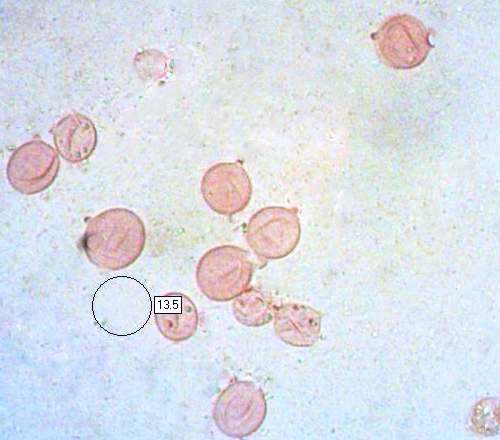Amanita ceciliae (Berk. and Broome) Bas - Snakeskin Grisette
Phylum: Basidiomycota - Class: Agaricomycetes - Order: Agaricales - Family: Amanitaceae
Distribution - Taxonomic History - Etymology - Identification - Culinary Notes - Reference Sources
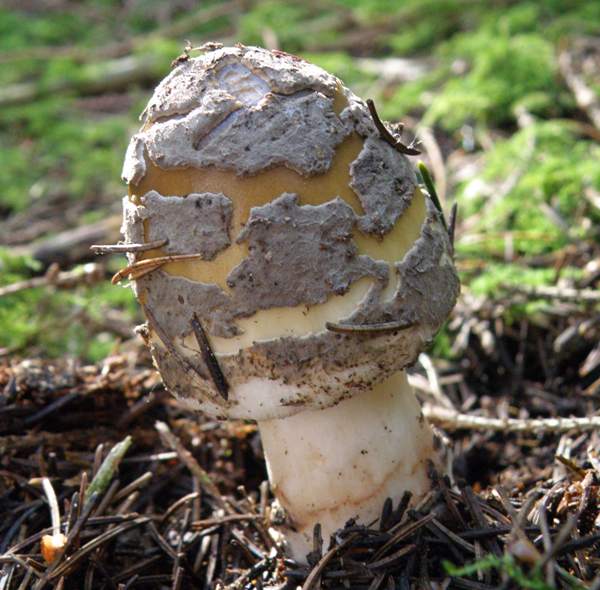
Less common but hardly less glamorous than Amanita crocea, the Orange Grisette, the Snakeskin Grisette is mycorrhizal with hardwoods and conifers.One of its older common names is Cecilia's Ringless Amanita, but I can find no information on the particular Cecilia (the saint, perhaps?) to whom this is a reference.
At maturity the caps usually flatten completely, retaining irregular grey veil fragments. (In West Wales on our forays we rarely see more than one or two of these mushrooms per year, but we will look out for some more mature specimens to photograph and add to this page.)
For a detailed description of the Amanita genus and identification of common species see our Simple Amanita Key...
Distribution
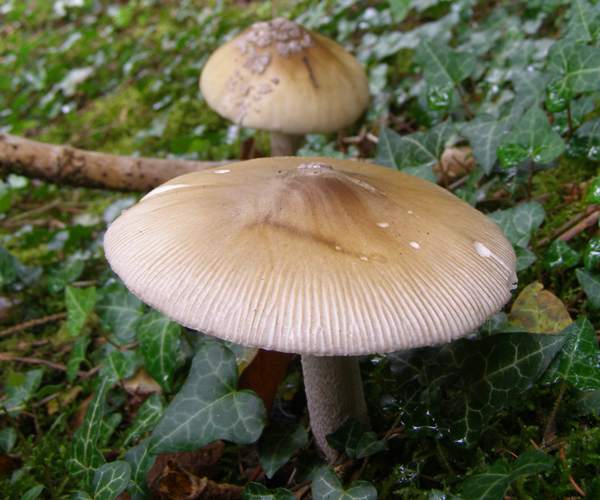
Infrequent in Britain and Ireland but widespread across most of mainland Europe, Amanita ceciliae (or a complex of species similar to the one found in Europe) is also reported from North America.
Taxonomic history
First described scientifically in 1854 by British mycologists Miles Joseph Berkeley and Christopher Edmund Broome (1812 - 1886), this mushroom was originally named Agaricus ceciliae. (Most of the gilled mushrooms were included initially in the genus Agaricus!) It was given its current name in 1984 by the Dutch mycologist Dr Cornelis Bas (born 1928).
Synonyms of Amanita ceciliae include Amanita inaurata Secr., Amanita strangulata sensu auct. mult., and Amanitopsis inaurata (Secr. ex Gillet) Fayod. (All of the ringless amanita species were formerly grouped into the now disused genus Amanitopsis.)
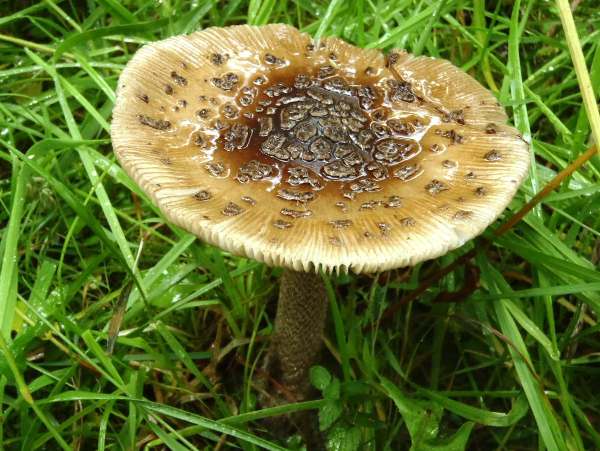
Etymology
The specific epithet ceciliae is in honour of Cecilia Berkeley, wife of English botanist-mycologist Miles Joseph Berkeley (co-author of this species). This was an acknowledgement of Cecilia Berkeley's involvement in her husband's mycological work.
Identification guide
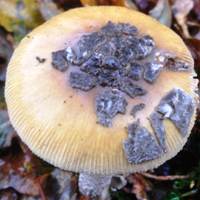 |
CapOlivaceous fawn, darkest at the centre, margin much paler, especially in immature specimens; margin with strong radial lines; irregular grey veil fragments mainly in cap centre; convex, eventually flattening; 6 to 12cm across. (Picture courtesy of Simon Harding.) GillsGills of Amanita ceciliae are creamy white, greying with age; they are free, with many short gills, and only moderately crowded. |
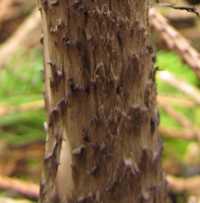 |
StemPale grey background, the surface developing snakeskin-like pattern of grey-brown scales - hence the common name Snakeskin Grisette. There is no ring on the 8 to 17cm long stem, which ranges from 1 to 2cm dia. The stem base is not swollen. |
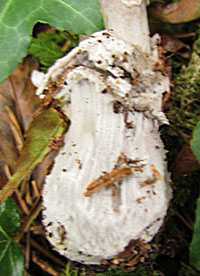 |
VolvaThe bag-like white volva of Amanita ceciliae soon collapses leaving patches on stem base. |
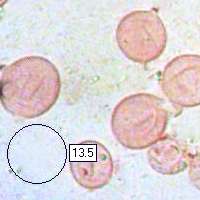 |
SporesSpherical or very nearly so, smooth, 10.5 - 14µm in diameter, inamyloid. Spore printWhite. |
Odour/taste |
Not significant. |
Habitat & Ecological role |
Mycorrhizal, in mixed woodland. |
Season |
August to November in Britain and Ireland. |
Similar species |
Amanita vaginata has a smoothish stem without a snakeskin pattern. Amanita fulva has a tawny-orange cap and white gills. Amanita crocea is orange and has a snakeskin-like pattern on its stem. |
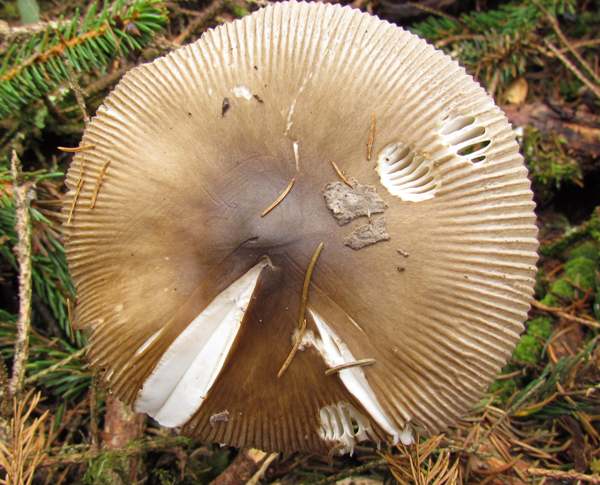
Culinary Notes
Unlike some of the other ringless amanitas (commonly referred to grisettes), this mushroom is reported to be at least slightly poisonous; however, in Wild Edible Fungi: A Global Overview Of Their Use And Importance To People by E. R. Boa, Amanita ceciliae is listed as 'food'. Some authorities state that this species is 'not known to be edible', while many field guides warn against collecting Amanita ceciliae because of the possibility of confusion with deadly poisonous Amanita species, and so my advice is that it should not be gathered for eating.
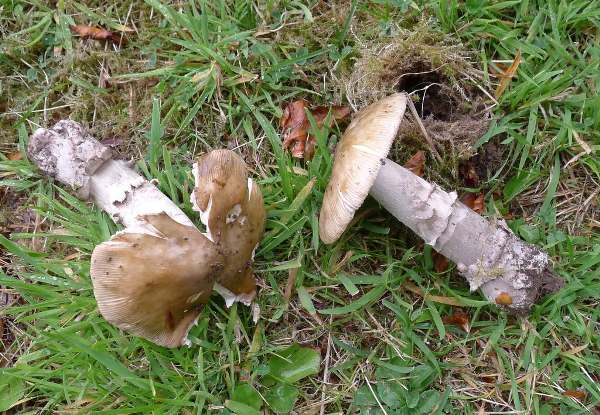
Reference Sources
Fascinated by Fungi, 2nd Edition, Pat O'Reilly 2016, reprinted by Coch-y-bonddu Books in 2022.
Funga Nordica: 2nd edition 2012. Edited by Knudsen, H. & Vesterholt, J.
BMS List of English Names for Fungi
Kibby, G (2012) Genus Amanita in Great Britain, published by Geoffrey Kibby.
Paul M. Kirk, Paul F. Cannon, David W. Minter and J. A. Stalpers (2008). Dictionary of the Fungi; CABI
Taxonomic history and synonym information on these pages is drawn from many sources but in particular from the British Mycological Society's GB Checklist of Fungi.
Acknowledgements
This page includes pictures kindly contributed by Simon Harding, Alistair Hutchison and Adam Pollard.
Fascinated by Fungi. Back by popular demand, Pat O'Reilly's best-selling 450-page hardback book is available now. The latest second edition was republished with a sparkling new cover design in September 2022 by Coch-y-Bonddu Books. Full details and copies are available from the publisher's online bookshop...
